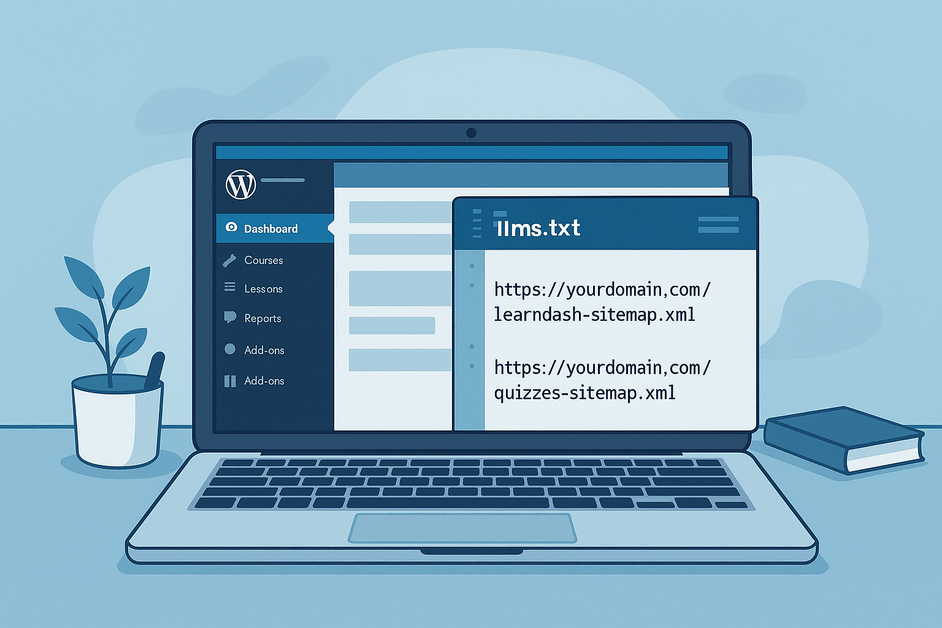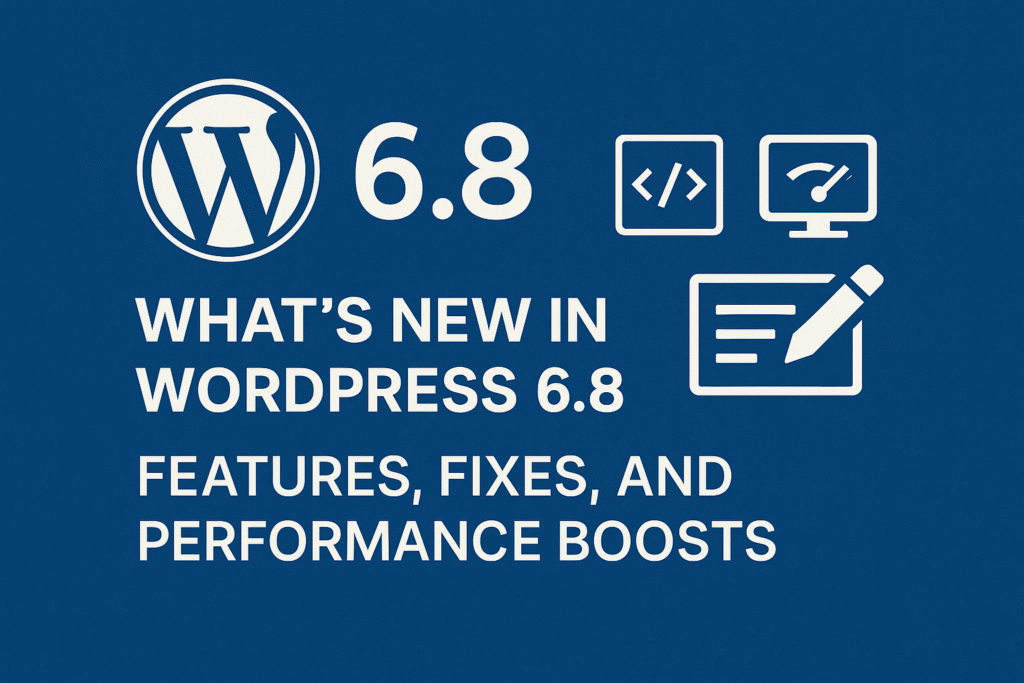
Table of Contents
Introduction: Why llms.txt Is a Game-Changer for WordPress LMS SEO
WordPress has solidified its position as the leading platform for creating dynamic Learning Management System (LMS) websites, powering online education with plugins like LearnDash, Tutor LMS, and LifterLMS. As the digital learning landscape grows, standing out in search engine results is crucial for attracting students. This is where llms.txt emerges as a vital tool for optimizing your site’s visibility.
Introduced by Google in late 2024, llms.txt acts as a specialized guide for search engine crawlers, ensuring they efficiently locate and index your course-specific sitemaps. This enhances discoverability, accelerates indexing, and strengthens your site’s search performance. Unlike generic SEO tactics, llms.txt is tailored for educational content, making it a must-have for 2025.
The rise of online learning has intensified competition among course creators, making it essential to leverage every available tool to capture audience attention. By streamlining how search engines process educational content, llms.txt empowers site owners to showcase their courses to a global audience, driving enrollments and engagement. Its seamless integration with existing WordPress workflows ensures that even non-technical users can implement it effectively.
Beyond technical benefits, this approach aligns with the broader shift toward user-centric search experiences. As learners increasingly rely on search engines to find relevant courses, ensuring your content is easily accessible can set your platform apart. This guide will equip you with the knowledge to harness this tool, optimize your site, and thrive in the competitive e-learning market of 2025.
In this detailed guide, we’ll explore what llms.txt is, its impact on WordPress LMS SEO, and step-by-step instructions to add llms.txt in WordPress. Whether you’re running a small course hub or a large e-learning platform, this file can significantly elevate your search rankings and student engagement.
Understanding llms.txt: A Deep Dive
The llms.txt file, short for Learning and Licensed Media Sitemap, is a straightforward text file designed to streamline how search engines process your LMS content. Similar to robots.txt in structure but distinct in purpose, it lists URLs of your LMS-generated sitemaps, enabling crawlers to prioritize educational resources like courses, lessons, and quizzes.
Why llms.txt Matters in 2025
As search engines refine their approach to structured data, Google’s 2025 algorithms emphasize indexing educational content more effectively. LMS plugins such as LearnDash and Tutor LMS create specialized sitemaps that can be overlooked without clear direction. By implementing llms.txt, you provide a direct pathway for crawlers, ensuring your content is indexed swiftly and accurately, which is critical for WordPress LMS SEO.
What Goes Into llms.txt?
The file is minimalist, containing only the URLs of your LMS sitemaps, one per line, in plain text. No directives, no formatting—just clean, crawlable links. For example:
https://example.com/learndash-courses-sitemap.xml
https://example.com/tutor-modules-sitemap.xml
https://example.com/assessments-sitemap.xml
This simplicity makes llms.txt a powerful ally for boosting Tutor LMS visibility and LearnDash SEO with minimal effort.
The SEO Benefits of llms.txt for WordPress LMS Sites
Adding llms.txt to your WordPress site delivers tangible advantages that enhance your search presence and user engagement:
- Enhanced Crawl Efficiency: By guiding crawlers to LMS-specific sitemaps, llms.txt ensures your courses, lessons, and certifications are discovered quickly, improving indexing speed and search rankings.
- Optimized LearnDash SEO and Tutor LMS Performance: Standard SEO plugins like Yoast or All in One SEO cover general optimization, but llms.txt specifically targets LMS content, making it indispensable for LearnDash SEO and Tutor LMS success.
- Rich Search Results: Proper sitemap indexing via llms.txt enables rich snippets, showcasing course details like duration, instructor bios, or ratings, which can increase click-through rates and user trust.
- Future-Ready SEO Strategy: With Google prioritizing structured educational data, llms.txt aligns your site with upcoming algorithm shifts, ensuring long-term WordPress LMS SEO resilience.
- Competitive Edge: Early adoption of llms.txt positions your site ahead of competitors who rely solely on traditional SEO methods, giving your courses a visibility boost.
llms.txt vs. robots.txt: A Clear Comparison
While both files reside in your site’s root directory, their roles in WordPress LMS SEO differ significantly:
| Feature | robots.txt | llms.txt |
|---|---|---|
| Purpose | Manages crawler access and restrictions | Directs crawlers to LMS sitemaps |
| Content | Allow/Disallow directives | Plain-text sitemap URLs |
| Target Crawlers | All web bots | Education-focused indexing bots |
| File Path | /robots.txt | /llms.txt |
| SEO Impact | Broad site management | Specialized for WordPress LMS SEO |
| Essential for LMS? | Optional for security | Highly recommended for LearnDash SEO and Tutor LMS |
This distinction underscores llms.txt’s unique role in enhancing educational content visibility.
How llms.txt Powers Search Engine Crawling
When a search engine visits your site, it follows a structured process:
- robots.txt: Checks for access permissions.
- sitemap.xml: Scans the general site structure.
- llms.txt: Targets LMS-specific sitemaps for educational content.
A valid llms.txt file ensures crawlers prioritize your LMS assets, leading to faster indexing, improved rankings, and a stronger WordPress LMS SEO foundation for platforms like Tutor LMS and LearnDash.
Step-by-Step Guide to Creating and Adding llms.txt in WordPress
Follow these streamlined steps to implement llms.txt and optimize your site’s SEO.
Step 1: Locate Your LMS Sitemaps
Your LMS plugin determines the sitemap URLs:
| LMS Plugin | Example Sitemap URL |
|---|---|
| LearnDash | /learndash-courses-sitemap.xml |
| Tutor LMS | /tutor-sitemap.xml |
| LifterLMS | /lifterlms-modules-sitemap.xml |
| MasterStudy | /courses-overview-sitemap.xml |
Navigate to yourdomain.com/sitemap.xml to identify these child sitemaps and copy their URLs.
Step 2: Build the llms.txt File
Using a text editor like Notepad++ or VS Code, list each sitemap URL on a new line. Save the file as llms.txt in plain text with UTF-8 encoding. Avoid adding comments or formatting to keep it clean.
Step 3: Add llms.txt to WordPress – Three Effective Methods
Method 1: Upload via Hosting File Manager
- Log into your hosting panel (e.g., SiteGround, Bluehost).
- Access File Manager and navigate to
public_html. - Upload
llms.txtto the root directory. - Verify at yourdomain.com/llms.txt.
Method 2: FTP Upload with Tools Like FileZilla
- Connect to your server using FTP credentials.
- Locate the
public_htmlfolder. - Drag and drop
llms.txtinto the root. - Confirm accessibility via your browser.
Method 3: Dynamic Generation with PHP (Advanced)
Add this code to your theme’s functions.php:
add_action('init', function() {
add_rewrite_rule('^llms.txt$', 'index.php?llms_txt=1', 'top');
});
add_filter('query_vars', function($vars) {
$vars[] = 'llms_txt';
return $vars;
});
add_action('template_redirect', function() {
if (get_query_var('llms_txt')) {
header('Content-Type: text/plain; charset=utf-8');
echo "https://yourdomain.com/learndash-courses-sitemap.xml\n";
echo "https://yourdomain.com/tutor-sitemap.xml\n";
// Add additional sitemaps as needed
exit;
}
});
Flush permalinks after adding. This method is ideal for automated updates and scalability.
Best Practices for Maximizing WordPress LMS SEO with llms.txt
To ensure optimal performance:
- Validate URLs: Include only active, error-free sitemap links.
- Regular Updates: Refresh llms.txt after adding new courses or switching plugins.
- SEO Plugin Synergy: Pair with Rank Math or Schema Pro for structured data enhancements.
- Google Search Console: Submit yourdomain.com/llms.txt for crawl monitoring.
- Browser Testing: Confirm the file displays plain URLs without HTML.
Testing Your llms.txt Setup
- Visit yourdomain.com/llms.txt to verify plain-text output.
- Check each sitemap URL for a 200 OK status code.
- Use Google Search Console’s URL Inspection tool to confirm crawler access.
- Monitor indexing progress in Search Console for insights into LearnDash SEO and Tutor LMS improvements.
Advanced Strategy: Combining llms.txt with Schema for Maximum Impact
To supercharge your WordPress LMS SEO:
- Leverage Schema Plugins: Use Rank Math or Schema Pro to add course-specific metadata (e.g., reviews, prerequisites).
- Integrate llms.txt: Ensure crawlers find these schemas via targeted sitemap links.
- Result: Enhanced rich snippets, better rankings, and increased click-through rates for LearnDash SEO and Tutor LMS.
This synergy creates a robust SEO framework tailored for educational platforms.
Wrapping Up: Take Action on llms.txt Today
For WordPress sites powered by LearnDash, Tutor LMS, or similar, incorporating llms.txt is a low-effort, high-reward step toward dominating 2025 search landscapes. It streamlines sitemap discovery, fortifies indexing, and elevates your overall WordPress LMS SEO.
Key takeaways:
- llms.txt lists your specialized LMS sitemaps in plain text.
- It enhances crawler efficiency for faster, more accurate indexing.
- Crucial for boosting LearnDash SEO and Tutor LMS performance.
- Easy upload or code integration in your site’s root.
- Regular updates keep it effective as your content grows.
Don’t wait—craft and add llms.txt in WordPress now to propel your online courses to new heights! 🌟
Expanding Your LMS Site’s Reach: Advanced Strategies Beyond llms.txt
As the online education sector continues to grow, WordPress remains a cornerstone for building robust learning management systems (LMS). With plugins powering course creation, the challenge lies in ensuring your content reaches the right audience through search engines. While tools like llms.txt streamline sitemap discovery, a comprehensive approach to optimizing your LMS site involves additional layers of strategy. This section explores advanced techniques to enhance your site’s visibility, user engagement, and long-term success in the competitive e-learning landscape of 2025.
The Evolving Landscape of Online Learning and Search
The demand for digital education has surged, with millions turning to online platforms for professional development, skill acquisition, and personal enrichment. Search engines have adapted to this trend by prioritizing high-quality, accessible educational content. Google’s 2025 updates emphasize structured data, user intent, and content relevance, making it critical for LMS site owners to align their strategies with these priorities. Beyond pointing crawlers to sitemaps, success hinges on creating a seamless user experience, leveraging analytics, and optimizing technical performance.
A well-optimized LMS site not only ranks higher but also fosters trust and engagement among learners. By combining technical enhancements, content strategies, and user-focused design, you can position your courses as authoritative resources in your niche. Let’s dive into actionable methods to elevate your site’s performance and complement the foundational work of sitemap optimization.
1. Crafting High-Quality, User-Centric Content
Content is the backbone of any successful LMS site. While sitemaps ensure discoverability, the quality of your course pages, blog posts, and supplementary materials determines whether visitors stay, enroll, or share your offerings. Here’s how to create content that resonates with both users and search engines:
- Focus on User Intent: Understand what your audience seeks—whether it’s beginner-level tutorials, advanced certifications, or quick skill refreshers. Tailor course descriptions, landing pages, and blog content to address specific pain points, such as “how to master data analysis” or “quick tips for public speaking.” Use clear, concise language to make your content accessible to diverse learners.
- Incorporate Multimedia: Enhance course pages with videos, infographics, and downloadable resources. Multimedia not only improves engagement but also increases dwell time, a key metric for search rankings. For example, embedding short preview videos of your courses can entice visitors to enroll while signaling relevance to crawlers.
- Regularly Update Content: Outdated course material can harm credibility and rankings. Schedule periodic reviews to refresh lesson plans, update statistics, and incorporate trending topics. For instance, a course on digital marketing should reflect the latest tools and platforms to remain competitive.
By prioritizing content that educates and engages, you create a virtuous cycle of higher rankings, increased traffic, and better user retention.
2. Leveraging Structured Data for Enhanced Visibility
Structured data, or schema markup, is a powerful tool for making your LMS content more understandable to search engines. While llms.txt guides crawlers to sitemaps, schema markup provides context about your courses, such as their format, duration, or prerequisites. This can lead to rich results in search, like star ratings or course details, which boost click-through rates.
- Implement Course Schema: Use plugins like Schema Pro or Rank Math to add course-specific schema to your pages. Include details like course title, description, instructor, and price. This not only enhances visibility but also aligns with Google’s push for structured educational content.
- Add FAQ Schema: Incorporate frequently asked questions on course pages to address common queries, such as “What is the course duration?” or “Are certificates provided?” FAQ schema can appear in search results, increasing Midjourney
- Use Review Schema: If your courses have user reviews, implement review schema to display star ratings in search results. This builds trust and encourages clicks, especially for competitive niches like online learning.
By enriching your pages with structured data, you make your content more appealing and accessible in search results, driving more qualified traffic to your site.
3. Optimizing Site Performance for Speed and Accessibility
A fast, accessible website is critical for both user satisfaction and search performance. Slow load times or poor mobile compatibility can deter learners and negatively impact rankings. In 2025, Google places significant weight on Core Web Vitals, such as loading speed, interactivity, and visual stability.
- Improve Page Speed: Use tools like Google PageSpeed Insights to identify bottlenecks. Compress images, enable browser caching, and leverage a content delivery network (CDN) to reduce load times. For example, optimizing large course preview images can significantly improve performance.
- Ensure Mobile-Friendliness: With many learners accessing courses on smartphones, a responsive design is non-negotiable. Test your site on multiple devices to ensure navigation, forms, and content display seamlessly.
- Enhance Accessibility: Make your site inclusive by adding alt text to images, ensuring keyboard navigability, and using high-contrast colors. This not only improves user experience but also aligns with search engine preferences for accessible content.
A technically sound site keeps learners engaged and signals quality to search engines, supporting long-term visibility.
4. Building Authority Through Backlinks and Outreach
Backlinks from reputable sites remain a cornerstone of search optimization. For LMS platforms, earning links from educational institutions, industry blogs, or course review sites can significantly boost authority.
- Guest Blogging: Write insightful articles for education-focused blogs, linking back to your courses. For example, a guest post on “Top 5 Skills for Career Growth” can naturally include a link to your relevant course.
- Partner with Influencers: Collaborate with educators or industry experts to promote your courses. Their endorsements, shared via blogs or social media, can drive traffic and build trust.
- Create Shareable Resources: Develop free resources like eBooks, webinars, or templates that link back to your site. For instance, a free guide on “Getting Started with Coding” can funnel users to your programming courses.
These efforts establish your site as a trusted resource, improving its ranking potential.
5. Harnessing Analytics for Continuous Improvement
Data-driven decisions are key to refining your LMS site’s performance. Tools like Google Analytics and Search Console provide insights into user behavior and search performance.
- Track User Journeys: Analyze which pages drive enrollments and where users drop off. For example, if many abandon the checkout page, streamline the process or add trust signals like testimonials.
- Monitor Search Performance: Use Search Console to track which queries bring traffic and identify opportunities to create targeted content. For instance, if “online photography course” drives clicks, develop related blog posts or landing pages.
- A/B Test Landing Pages: Experiment with different headlines, calls-to-action, or layouts to optimize conversions. Testing a “Start Learning Now” versus “Join Our Course Today” button can reveal what resonates.
Regular analysis helps you adapt to learner needs and search trends, ensuring sustained growth.
6. Engaging Your Audience Beyond Search
While search visibility is crucial, direct engagement with your audience builds loyalty and drives organic traffic. Consider these strategies:
- Email Marketing: Build a mailing list to share course updates, discounts, or exclusive content. A weekly newsletter with learning tips can keep your brand top-of-mind.
- Community Building: Create forums or social media groups where learners can discuss courses and share insights. A vibrant community enhances retention and encourages word-of-mouth promotion.
- Interactive Elements: Add quizzes, polls, or live Q&A sessions to your site to boost engagement. For example, a quick quiz on “Which Programming Language Suits You?” can guide users to relevant courses.
These efforts create a loyal user base that amplifies your site’s reach through shares and referrals.
7. Staying Ahead of Algorithm Changes
Search algorithms evolve rapidly, and staying proactive ensures your LMS site remains competitive. Subscribe to SEO blogs, attend webinars, and monitor Google’s Webmaster Central Blog for updates. For instance, preparing for shifts in how educational content is prioritized can give you an edge.
By integrating these advanced strategies—high-quality content, structured data, technical optimization, backlink building, analytics, and audience engagement—you create a holistic approach that complements sitemap-focused tools like llms.txt. This multifaceted strategy ensures your LMS site thrives in 2025’s competitive online learning market, driving traffic, enrollments, and long-term success.
Conclusion: Transform Your LMS Site with llms.txt in 2025
For WordPress sites powered by LearnDash, Tutor LMS, or similar plugins, llms.txt is a low-effort, high-reward addition to your SEO toolkit. By guiding search engines to your LMS sitemaps, it accelerates indexing, enhances visibility, and prepares your site for Google’s focus on structured learning content. Whether you’re aiming to boost LearnDash SEO, elevate Tutor LMS rankings, or attract more students, adding llms.txt in WordPress is a strategic move. Create your file, upload it today, and unlock the full potential of your online courses! 🚀
Frequently Asked Questions on llms.txt, Adding llms.txt in WordPress, and WordPress LMS SEO
Explore these Rank Math-compatible FAQs to deepen your understanding of llms.txt and its role in enhancing WordPress LMS SEO, LearnDash SEO, and Tutor LMS visibility. These questions are inspired by common People Also Ask (PAA) queries to help optimize your online course site’s search performance.
We hope these FAQs have clarified how to leverage llms.txt for your WordPress LMS site. If you have more questions on adding llms.txt in WordPress or optimizing LearnDash SEO and Tutor LMS, feel free to reach out!
Key Takeaways: Mastering llms.txt for WordPress LMS SEO
- llms.txt Defined: A simple text file listing LMS sitemap URLs, designed to guide search engines to your educational content for faster indexing.
- SEO Powerhouse: Enhances WordPress LMS SEO by improving crawl efficiency, boosting LearnDash SEO, and increasing Tutor LMS visibility.
- Rich Snippet Potential: Enables course-specific rich results, like ratings or durations, to attract more clicks and engagement.
- Easy Implementation: Add llms.txt in WordPress via File Manager, FTP, or PHP code, making it accessible for all skill levels.
- Future-Proof Strategy: Aligns with Google’s 2025 focus on structured data, ensuring sustained rankings for your LMS site.
- Best Practices: Use valid URLs, update regularly, pair with schema plugins, and verify via Google Search Console for optimal performance.
- Actionable Next Step: Create and upload llms.txt to your site’s root to elevate your course visibility and WordPress LMS SEO today!
🚀 Launch Your Online Dreams with Hostinger!
The information provided on this website is for general informational purposes only. While we strive to keep the content accurate and up-to-date, we make no guarantees of any kind about the completeness, reliability, or suitability of the information. Any action you take based on the information on this website is strictly at your own risk.
💲 Affiliate Disclosure:Some of the links in this post may be affiliate links. This means we may earn a small commission if you click on the link and make a purchase, at no additional cost to you. This helps support our work and allows us to continue providing quality content. We only recommend products or services we believe will add value to our readers.
✨ Connect with Us ✨
Stay updated with our latest WordPress guides, SEO tips, and AI tools. Follow us on social media or reach out via email!
You May Also Like:
Explore more powerful insights to level up your WordPress and SEO game:
💡 Keep exploring insightful tips and strategies at WordPressGuruPro.com


